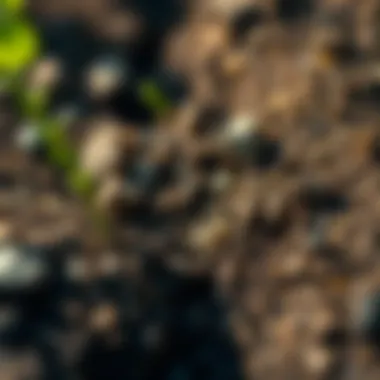Understanding Granular Factors in Pest Management


Intro
Pest management is a delicate dance, intricately woven into the fabric of our ecosystems. When we think of pest control, we often focus solely on the pests themselves, overlooking the underpinnings of their existence: the very soil beneath our feet. It is vital to recognize that pests do not act in isolation; they are deeply influenced by the granular nature of Mother Earth. This article sets out to explore how soil health, ecological dynamics, and environmental factors converge to impact pest behavior and populations.
By connecting the dots between soil composition and pest trends, homeowners can adopt more sustainable practices that not only control pests but also harmonize with the environment. Our aim is to delve into this complex relationship, offering actionable insights for thoughtful pest management that emphasizes ecological balance. Let’s embark on this journey to foster sustainable and healthy environments for both humans and the critters that inhabit them.
Understanding the Pest
Identification
Understanding the enemy is half the battle. Identification goes beyond merely recognizing a pest; it involves comprehending its role in the ecosystem. Common garden pests such as aphids, thrips, and spider mites can cause significant damage if left unchecked. However, each of these pests comes with its own behavioral patterns and vulnerabilities.
Take the aphid for example: these small, sap-sucking insects often form large colonies. They thrive in warm temperatures and especially love plants with lush, tender new growth. If you're seeing them, it's often a sign that your plants are healthy, too healthy perhaps, making them prime targets for these pests. Recognizing the tell-tale signs of the presence of pests is crucial. Here are a few identifiers:
- Color and Size: Aphids are usually green or black, just a few millimeters in length.
- Webbing: If you notice fine silk webs, it could be a sign of spider mites.
- Sticky Residue: This often indicates a sap-sucking pest, such as whiteflies or aphids.
Life Cycle
Understanding the life cycle of pests adds another layer to effective pest management. Most pests undergo distinct life stages: egg, larva, pupa, and adult. For instance, the lifecycle of the common housefly comprises about 8 to 10 days from egg to adult under optimal conditions. Therefore, timing intervention is key; targeting pests early in their life cycle can help manage populations more effectively.
Here's a quick breakdown of a typical pest lifecycle:
- Egg Stage: Often hidden in less visible areas.
- Larvae Stage: This is the feeding stage; pests grow rapidly resulting in the most damage.
- Pupa Stage: Dormant phase where transformation occurs.
- Adult Stage: The reproductive phase where more eggs are laid, perpetuating the cycle.
By understanding these nuances, homeowners can tailor their pest management strategies accordingly, striking while the iron is hot, so to speak.
Pest Prevention Strategies
Environment Modification
Changing the environment to make it less hospitable to pests is a smart and sustainable approach. Many pests thrive under certain conditions, so modifying your environment can help diminish their populations. For instance, keeping the garden tidy, removing debris, and maintaining proper drainage can significantly reduce pest breeding sites. Here are some strategies to consider:
- Eliminate Standing Water: Mosquitoes breed in stagnant water, capsizing their population by ensuring proper drainage.
- Control Soil pH: A balanced soil pH can help discourage certain pests while promoting plant health.
- Enhance Plant Diversity: Diverse plants create a more balanced ecosystem, confusing pests and providing habitats for beneficial insects.
Physical Barriers
Sometimes, sheer ingenuity can serve as your best line of defense against pests. Physical barriers are an effective, chemical-free way to protect your plants. Common methods include:
- Netting: Fine mesh can keep flying insects at bay while allowing sunlight and rain.
- Mulching: Organic mulch not only retains moisture but also deters certain pests.
- Row Covers: Lightweight fabric can protect young plants during vulnerable growth periods.
These measures can create an unwelcoming atmosphere for pests, safeguarding your home without resorting to harsh chemicals.
Control Methods
Chemical Control
There are times when physical measures may not suffice. In such cases, chemical control can be a part of a comprehensive pest management strategy. However, it's essential to choose wisely. Products like neem oil or insecticidal soaps offer a more environmentally friendly option compared to traditional pesticides. Always read labels carefully and follow instructions to mitigate any potential harm to beneficial insects.
Biological Control
Lastly, harnessing nature’s own mechanisms can lead to effective pest management without the use of chemicals. Biological control involves introducing or conserving natural predators that keep pest populations in check. Ladybugs, for example, are notorious for targeting aphids. It’s like throwing a spanner in the works for pest populations. Consider these biological control methods:
- Encourage Natural Predators: Attract birds or beneficial insects to your garden.
- Companion Planting: Certain plants can repel pests when grown alongside others, creating a dynamic defense.
"A balanced ecosystem is the best pest management strategy; nature knows how to balance itself."
Epilogue
Navigating pest management through the lens of soil health and ecological dynamics is not only insightful but necessary for sustainable living. This article has laid the foundational stones of understanding pests, prevention strategies, and control methods, guiding homeowners towards a healthier coexistence with the inhabitants of their gardens.
As we deepen our grasp on the granularity of Mother Earth, we begin to appreciate the complex relationships that underline pest management, leading us to solutions that don’t just address immediate concerns but support the growth of a thriving, balanced environment. For further resources, consider visiting Wikipedia or Britannica for deeper insights on pest management practices.
Preamble to the Granular Concept of Mother Earth


The understanding of the granular nature of our planet is a crucial aspect that connects various fields such as ecology, agriculture, and pest management. The soil, often perceived as a mere growing medium, is in fact a complex interplay of living organisms, inorganic minerals, organic material, and air. This intricate system plays a pivotal role in determining pest populations and their behaviors. When we think about Mother Earth, we must consider her diverse layers, each contributing uniquely to the environmental tapestry we rely on.
Recognizing this granularity helps homeowners and housewives understand how their gardening choices can affect not just their plants, but also the broader ecosystem. It draws attention to the importance of nurturing the ground beneath our feet. The benefits of adopting a granular perspective cannot be overstated; it allows us to embrace sustainable practices that not only promote plant health but also reduce pest problems naturally.
The thoughtful management of soil composition can lead to healthier gardens and a more balanced ecosystem. As we explore the individual components of this granular concept, we get a clearer picture of how to combat pest issues effectively. This article aims to enlighten readers on essential ecological truths, thereby equipping them to make informed decisions about pest control in their homes.
Defining Granularity in Ecological Terms
Granularity in ecological terms goes beyond the size of particles and encompasses the diversity and complexity within the ecosystem. It refers to the differentiation of soil layers, the myriad of microorganisms residing in it, and the varied organic matter that contributes to soil fertility. Each layer is like a chapter in a book, where every story — every interaction — has a role to play in pest dynamics.
For instance, consider the organic matter component. When plant debris decomposes, it creates a nutrient-rich layer that supports beneficial insects. These insects, in turn, regulate pest populations through natural predation. In this way, spatial differentiation in soil promotes biodiversity, which is a key finding of modern ecological studies. By understanding how granularity applies here, we can appreciate how these interactions form the backbone of a balanced ecosystem.
Importance of Soil Composition in Pest Management
The composition of the soil serves as a fundamental pillar for effective pest management. When the soil is healthy, its ability to support crops and plants improves significantly, leading to lesser reliance on chemical pesticides. A diverse soil composition rich in organic matter and nutrients provides a conducive environment for beneficial microorganisms and insects while creating challenges for harmful pests.
Homeowners should aim for a soil mix that consists of:
- Clay for moisture retention
- Sand for drainage and aeration
- Silt for nutrient holding
- Organic compost to boost life and fertility
When these components come together, they create a resilient ecosystem where pests have a more challenging environment. For example, a rich organic layer can attract natural predators like ladybugs or lacewings, which keep aphid populations in check. Fostering soil diversity is not just good gardening practice; it’s the cornerstone of sustainable pest management.
By understanding and optimizing soil composition, you not only nurture your plants but also create a more balanced environment. This translates to healthier gardens that naturally resist pest infestations.
In summary, the granular nature of our planet is not just an academic concept; it's a practical framework that can help transform pest control practices in homes nationwide. By recognizing the significance of soil composition and ecology, we can all contribute to a more sustainable and thriving environment.
Soil as a Living Entity
Soil is often underestimated, seen merely as a passive medium for plant growth. However, the reality is far more intricate and dynamic. Thinking of soil as a living entity reveals its importance in the ecosystem, especially in the context of pest management. This perspective underscores the interconnections between soil health, biodiversity, and pest dynamics. By acknowledging soil as a vibrant habitat, we can better understand how to foster a balanced ecosystem that benefits both human needs and the natural environment.
Microbial Life and Soil Health
Microbial life is the unsung hero of soil. Billions of microorganisms, including bacteria, fungi, and protozoa, thrive in this habitat, contributing significantly to soil health. These microscopic organisms play several roles, from breaking down organic matter to enhancing nutrient availability for plants. When soil hosts a rich diversity of microbes, it promotes healthier plants, which in turn can resist pest infestations more effectively.
Microbial activities are crucial for maintaining soil structure and fertility. For instance, mycorrhizal fungi form symbiotic relationships with plant roots, facilitating water and nutrient uptake. In addition, certain bacteria can convert atmospheric nitrogen into forms that plants can utilize, boosting their growth and resilience. Because of this intricate web of life, tending to microbial health in the soil can lead to natural pest resistance, reducing the need for chemical interventions.
The Role of Organic Matter
Organic matter is another key player in the narrative of soil as a living entity. Composed of decomposed plant and animal materials, organic matter enriches the soil, enhancing its fertility and structure. It acts like a sponge, improving the soil's ability to retain moisture while also providing food for a variety of soil organisms.
When homeowners incorporate compost or other organic materials into their gardens, they contribute to a more thriving ecosystem. This not only boosts plant growth but also supports a diversity of beneficial organisms that can help suppress pest populations. The correlation between healthy soil and pest management is clear: the greater the organic matter, the fuller the life teeming within the soil, and the better equipped plants are to fend off pests.
Nutrient Cycling and Pest Dynamics
Lastly, nutrient cycling within soil brings everything full circle. Healthy soil contributes to a balanced nutrient cycle, which is vital for sustaining plant life. When nutrients are available in excess or deficiency, it can trigger pest outbreaks, as certain pests may thrive in unbalanced conditions.
Understanding this cycle is essential for effective pest management. For example, excessive use of fertilizers can lead to nutrient runoff, altering the ecological balance and causing an increase in certain pest species. A focus on maintaining soil health through organic amendments not only reduces these risks but also cultivates an environment where beneficial insects contribute to pest control.
"Healthy soil is not just the foundation of agriculture; it is the bedrock of a sustainable ecosystem, balancing the relationships between plants, pests, and the myriad organisms that dwell beneath our feet."
Granular Systems and Biodiversity
Granular systems play a critical role in fostering biodiversity, which in turn has significant implications for pest management. The complex interactions found within these systems create a robust environment that can naturally regulate pest populations. It’s like a finely tuned orchestra, where each instrument — or species — contributes to the overall harmony.
One important aspect is the ecological niche. Understanding these niches helps identify how different species coexist and what resources they depend on. For example, consider the various plants in a garden. Each plant species has unique requirements for sunlight, water, and nutrients. This variety not only enriches the soil but also creates a balanced ecosystem where pests are kept in check by natural predators.
When different plants share a space, they can provide shelter and food for beneficial insects, which can drive off harmful pests. A simple wildflower patch can attract pollinators, while simultaneously hosting insects that control aphid populations naturally. This interplay underscores how biodiversity can lead to a more resilient environment.
Moreover, the introduction of a variety of species into a granular system leads to increased nutrient cycling. More diverse soil microorganisms work through the decomposition of organic materials, releasing nutrients crucial for plant growth. When plants thrive, they can better withstand pest pressures. It’s an intricate dance of give and take, where the presence of one species can either bolster or hinder another.
"The richness of life forms in a system can improve its resilience and adaptability to change, particularly in the face of pest outbreaks that threaten agricultural yields."
Understanding Ecological Niches


The concept of ecological niches is fundamental in understanding how species interact within granular systems. Each species occupies a specific niche, enjoying certain benefits while contending with competition and predation. This concept helps clarify why some pests flourish in certain conditions while others don't. For instance, if you have a dense stand of a single crop, pests may find an abundant food supply without natural predators. Conversely, a diverse planting scheme reduces the chances of any single pest overwhelming the system.
The idea of complementary niches also comes into play. For instance, planting sweet basil alongside tomatoes can repel pests specific to tomatoes by improving air circulation and deterring aphids, highlighting the benefits of strategic plant placement. In maintaining biodiversity, we encourage natural pest control methods, creating a healthy balance within our gardens.
Interactions Between Species
Interactions between species can take many forms; symbiosis, predation, and competition, to name a few. Understanding these dynamics allows homeowners to create environments that naturally support beneficial species while minimizing harmful pests. For example, mutualistic relationships — where both parties benefit — can be seen in the interaction between flowering plants and their pollinators. Plants provide nectar while pollinators facilitate reproduction, resulting in more fruitful plants.
On the other hand, we cannot overlook competitive interactions. In a granular environment, too many of one type of species can lead to resource depletion, potentially allowing pests to proliferate. Thus, a well-cultivated variety can free regions of the garden from pest populations by ensuring that no single species dominates. Regularly reviewing plant health and diversity ensures that these interactions remain beneficial and balanced.
The Role of Beneficial Insects
Beneficial insects are the unsung heroes of the ecosystem. While not all insects are pests, many serve vital roles in pest management. Predatory insects, like ladybugs and lacewings, feast on aphids, helping to reduce their populations notably. Other insects, such as bees and butterflies, are crucial for pollination, which directly influences fruit and vegetable yield. Integrating specific plants that attract these beneficial insects can significantly mitigate pest problems.
Of further note are decomposers, those tiny critters breaking down organic matter back into the soil, circulating nutrients that benefit plant life. This is crucial for a healthy soil system which not only nurtures the plants we want to thrive but also inherently limits pest populations by keeping the overall ecosystem in balance.
In summary, fostering a system rich in biodiversity through the understanding of ecological niches, species interactions, and the role of beneficial insects plays an instrumental role in developing an effective pest management strategy. Homeowners can reap rewards not only in flourishing gardens but also in reduced pest issues, connecting back to the wisdom of Mother Earth.
Environmental Influences on Granularity
Soil does not exist in a vacuum. It is a living, breathing entity that interacts constantly with its surroundings. Understanding the environmental influences on soil granularity is a crucial step in pest management. Granularity refers to the varied size distribution of soil particles, and its effects ripple through every facet of ecosystem health. When we dive into this topic, it's not just about dirt; it's about the very essence of life underground that supports everything from crops to those pesky critters we often want to get rid of.
Climate Effects on Soil Structure
Climate plays a sizeable role in shaping the structure of soil. Variations in temperature, precipitation, and seasonal changes can alter the physical and chemical properties of soil. For instance, heavy rainfall can lead to soil erosion, washing away essential nutrients that pests depend on for survival. Conversely, prolonged droughts can harden soil, making it less pliable for plant roots and depriving pests of their food sources.
- Temperature's Role: Soil temperatures can influence microbial activity, which in turn affects nutrient availability. When the soil is warm, microbial processes are sped up, leading to quicker decomposition of organic materials. However, excessive heat can also kill off beneficial microorganisms, tipping the balance in favor of harmful pests.
- Moisture Levels: Too much or too little moisture can affect the soil structure severely. Well-structured soil with adequate water retains nutrients needed for healthy plant growth. In contrast, overly compacted dry soil can create a hostile environment, driving pests deeper underground or away entirely. This means that understanding local climate patterns may help homeowners anticipate pest outbreaks.
"The weather is like a mosaic. Each tile representing a piece of the puzzle of granularity and pest dynamics. Change one tile, and the whole image can shift."
Human Impact on Ecosystems
Of all the influences on soil granularity, human impact is arguably the most profound. Urbanization, agriculture, and industrial activities have drastically altered landscapes. The consequences can be dire for both soil health and pest management strategies. When we over-plow fields, build concrete jungles, or use chemical fertilizers, we disrupt the natural balance.
- Agricultural Practices: Conventional farming methods, which often include monoculture and the excessive use of pesticides, can lead to a decline in soil health. This increase in soil nutrient depletion promotes pest populations as natural competition is diminished.
- Urban Development: Expanding cities change the natural drainage and compact soil structures. When water runs off impermeable surfaces, it can lead to flooding and erosion in surrounding areas, impacting local ecosystems. This alteration creates ideal conditions for pests that thrive in disrupted environments.
The connection between environmental influences on granularity and pest management isn't just theoretical. It's practical and pivotal. Recognizing these influences enables homeowners to adopt strategies that harness nature rather than fight against it. For instance, incorporating organic mulches can help retain soil moisture while promoting a healthy ecosystem underground. By understanding how to work with the environment, we can create a sustainable approach to pest management.
Practical Applications in Pest Management
Understanding how granular properties manifest in our environment offers pivotal insights for effective pest management. This not only involves a shift towards more sustainable practices but also emphasizes the intricate relationship between soil health and pest behavior. The aim here is to empower homeowners with practical strategies, while also providing professionals with innovative techniques. This dual approach ensures that we address pest issues without compromising the ecosystem we live in.
Sustainable Practices for Homeowners
Homeowners can adopt various sustainable practices that minimize pest problems while promoting a healthy environment. For starters, encouraging biodiversity around the home is crucial. When you create spaces for beneficial insects, such as ladybugs and lacewings, you promote a natural balance that keeps harmful pests at bay. Here are some practical steps to consider:
- Plant native species: Natives are adapted to your area and require less maintenance and resources, helping local ecosystems thrive.
- Companion planting: Certain plants can naturally repel pests or attract beneficial insects. For instance, marigolds deter nematodes and mosquitoes, making them great companions for vegetable gardens.
- Natural repellents: Utilizing insect-repelling plants like citronella or using essential oils can deter pests without resorting to chemicals.
By integrating such practices into your gardening routine, you can build a resilient ecosystem that supports both plants and natural pest predators.
Innovative Techniques for Professionals
For pest management professionals, embracing innovative techniques is vital to remain effective and relevant in a rapidly changing environment. One promising approach is the use of integrated pest management (IPM), which incorporates a variety of control methods tailored to the unique challenges posed by different pests. Key techniques include:
- Monitoring and assessment: Regularly inspect sites for pest activity and identify the species involved to tailor your approach effectively.
- Biopesticides: Derived from natural materials, these alternatives to traditional pesticides are often safer for the environment and can be very effective. Products like Bacillus thuringiensis attack the larvae of certain pests while being harmless to beneficial insects.
- Soil health amendments: Testing soil regularly and adjusting pH, nutrient levels, and organic matter can lead to healthier plants that are less susceptible to pest infestations.
Moreover, technological advancements like drones for mapping and monitoring can offer unprecedented levels of detail in pest detection.
Integrating Granular Insights into Pest Control Strategies
A thorough understanding of granular insights can play a critical role in shaping effective pest control strategies. This means analyzing how soil composition affects not just pest populations but their interactions with the wider ecosystem. Here’s how to integrate these insights:
- Soil Restoration: Rebuilding soil structure through composting or the introduction of organic matter can enhance microbial activity, directly influencing pest dynamics.
- Adaptive management: Rely on real-time data to adjust pest control strategies based on environmental changes or pest behavior fluctuations. Factors like moisture content and soil temperature can vastly influence pest emergence and prevalence.
- Education and engagement: Continually educate clients about the ecological implications of pest management decisions, encouraging a perspective that sees the interconnectedness of life rather than a simple fight against pests.


"The success of pest management lies in embracing the natural behaviors and cycles of the ecosystem—working with it, not against it."
To wrap it up, practical applications in pest management hinge significantly on an understanding of the granular aspects of soil and biodiversity while promoting sustainable methods. By implementing these practices, homeowners can protect their living spaces, and professionals can improve their strategies, leading to a healthier environment for all.
Case Studies of Granular Approaches
Examining real-world implementations of granular approaches to pest management provides invaluable insights that can be applied by both amateurs and professionals alike. These case studies not only showcase the effectiveness of eco-friendly methods but also draw attention to the underlying ecological principles that drive pest control strategies. Learning from past successes and challenges helps ensure ongoing improvement and adaptation of practices tailored to diverse environments.
Successful Eco-Friendly Pest Management
One prominent case study involves a community garden in suburban California that faced a persistent aphid problem. Traditional pesticide use was high, and the ecosystem was suffering. The garden team decided to leverage granular principles of pest management by introducing beneficial insects like ladybugs and lacewings. They also focused on enhancing soil health. This meant adding organic compost, which not only revitalized the soil but also attracted a broader spectrum of beneficial organisms.
The outcome? Over the course of one season, aphid populations dwindled significantly. The garden thrived, showing that a balance in the ecosystem creates natural checks on pest populations. Homeowners can adopt similar strategies, emphasizing biological controls over harmful chemicals, reducing environmental stress, and promoting a healthier outdoor space.
Comparative Analysis of Techniques
In another example from an urban landscaping project in New York City, a combination of techniques was applied to tackle pest issues. The project team compared treated plots, one with synthetic chemicals and the other with eco-friendly practices including neem oil and diatomaceous earth.
The difference was quite remarkable: the treated plots with synthetic chemicals showed initial pest reduction but later suffered from pest resurgence due to diminished natural predator populations. In contrast, the eco-friendly plots maintained lower pest levels longer and promoted biodiversity.
Key takeaways from this analysis include:
- Ecosystem Balance: A healthy ecosystem is vital for sustainable pest management.
- Long-term Strategy: Eco-friendly methods may take longer to show results, but they provide lasting solutions.
- Adaptability: Techniques must be adapted to the specific needs of the environment and pest types.
In summary, these case studies illustrate how granular approaches can lead to more effective and sustainable pest management strategies. Understanding local ecosystems and applying tailored methods fosters a comprehensive and effective response to pest challenges, paving the way for long-term environmental health.
Future Directions in Granular Research
The study of soil and its components is an evolving field that holds significant implications for pest management. Granular research not only delves into the soil structure but also considers how its health directly affects pest populations and biodiversity. As the solutions to pest problems increasingly lean towards sustainable practices, understanding the future directions in granular research is essential.
The significance of this topic lies in adapting to the changing environmental conditions and understanding the nuanced interactions within ecosystems. With climate change and urbanization altering landscapes, future research must address how soil responds to these shifts. Closely related is the idea that healthier soils lead to better pest management outcomes. Here, organic compounds, nutrient presence, and microbial activity all interplay to either attract or deter pests.
Emerging Trends in Soil Science
In the quest for improved pest management, several emerging trends in soil science are coming to the fore:
- Regenerative Agriculture: This involves practices that restore soil health by enhancing organic matter and promoting biodiversity. Techniques such as cover cropping and minimized tillage are gaining traction.
- Soil Health Assessments: New methods for assessing soil health are being developed, focusing on biological soil properties rather than just chemical makeup. These assessments can lead to more tailored pest management strategies.
- Precision Agriculture: Technologies are being refined that allow for precision in applying fertilizers, pesticides, and water. This reduces excess application, ultimately benefiting soil health and minimizing pest outbreaks.
These trends emphasize a shift from traditional practices to a more holistic and integrative approach. It’s not just about tilling the soil; it’s about understanding its unique qualities and responding appropriately.
Innovations in Pest Management Technologies
As researchers delve deeper into granular insights, innovations in pest management technologies are swiftly following suit:
- Biopesticides: Derived from natural materials, these pesticides are designed to target pests without harming beneficial insects or the environment. Research into their effectiveness and application is on the rise.
- Smart Pest Monitoring: New technologies allow homeowners and professionals alike to monitor pest activity through apps and sensors. These devices can provide real-time data, helping adjust management practices on the fly.
- Drone Technology: Drones can survey vast areas, pinpointing pest hotspots and providing critical data on soil health and crop status. This fine-tuning of pest management strategies can lead to more effective solutions.
"Embracing these innovations will require not just investment but also a cultural shift toward understanding and valuing our soils as living ecosystems."
As we explore these advances, it's clear that a synergy between soil science and pest management will enhance our ability to foster healthier environments. Knowing how to harness these future directions will ultimately result in more robust pest control strategies that are effective yet considerate of the eco-system.
For further reading on the role of soil health in agriculture and pest management, consider checking sources like Wikipedia, Britannica, or USDA.
Ending
In the realm of pest management, understanding the granular insights of soil and ecological systems is crucial. This article has laid down the foundation for recognizing the complex interplay between soil health, biodiversity, and pest control. By grasping these connections, homeowners and pest control professionals alike can adopt practices that are not only effective but also sustainable.
Summarizing the Granular Perspective
To encapsulate the granular perspective, it's vital to realize that soil is more than just a growing medium. The layers of soil harbor communities of life, from tiny microbial entities to larger insects, all playing roles in the health of our ecosystems. The combination of these living organisms contributes to nutrient cycling, disease suppression, and overall garden wellbeing.
When considering pest issues, it is essential to look beyond immediate solutions, such as chemical pesticides. Instead, one should reflect on the soil's contributors. A balanced ecosystem can deter many pests naturally, which aligns with the principles of sustainable pest management. For example, maintaining organic matter not only feeds the soil but also increases its robustness against pest invasions, thus promoting a healthier environment for both plants and beneficial insects.
Call for a Holistic Approach in Pest Management
- Encourage practices like composting and mulching that enhance soil structure.
- Foster beneficial insect populations by using companion planting techniques.
- Regularly monitor soil health to make informed choices about pest control methods.
"An ounce of prevention is worth a pound of cure." This adage holds significant value when considering pest management. Investing in soil health and biodiversity today can save homeowners from potential pest issues tomorrow. By embracing a granular perspective, we foster not just our gardens but our local ecosystems, ensuring a balanced relationship that benefits all living entities.
In the end, adopting a strategy where ecological principles guide actions can yield better outcomes for pest management, benefiting homeowners and the environment as a whole.







